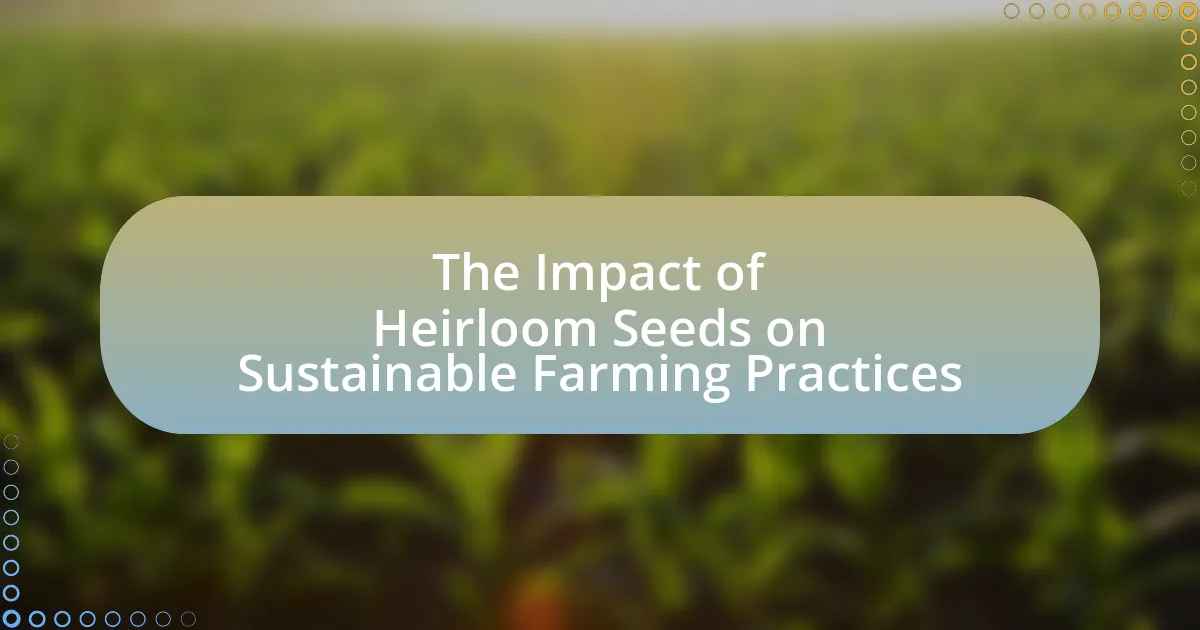The article explores the cultural heritage of heirloom varieties, emphasizing their significance in traditional agriculture, biodiversity, and historical context. Heirloom varieties, which are open-pollinated and have been cultivated for generations, differ from modern cultivars in genetic diversity and adaptability. The article highlights the unique characteristics of heirloom plants, their role in preserving cultural identity, and the importance of maintaining these varieties for future generations. Additionally, it discusses methods of preservation, including seed saving and community gardening, and the environmental and culinary benefits associated with cultivating heirloom crops.

What is the Cultural Heritage of Heirloom Varieties?
The cultural heritage of heirloom varieties encompasses the traditional agricultural practices, biodiversity, and historical significance associated with these plants. Heirloom varieties are cultivated for generations, often passed down through families, reflecting local customs and agricultural knowledge. For instance, the preservation of heirloom tomatoes in the United States showcases regional flavors and farming techniques that have been maintained over time, contributing to food security and cultural identity. This connection to heritage is vital, as it fosters community resilience and promotes sustainable farming practices, ensuring that unique genetic traits are preserved for future generations.
How do heirloom varieties differ from modern cultivars?
Heirloom varieties differ from modern cultivars primarily in their genetic diversity and cultivation practices. Heirloom varieties are open-pollinated, meaning they can reproduce true to type, preserving unique traits over generations, while modern cultivars are often hybrids or genetically modified for specific traits such as uniformity, disease resistance, and shelf life. Historical records indicate that heirloom varieties have been cultivated for at least 50 years, often passed down through generations, which contributes to their rich genetic diversity and adaptability to local growing conditions. In contrast, modern cultivars are typically developed by agricultural companies and may lack the same level of genetic variation, making them more susceptible to pests and diseases.
What characteristics define heirloom varieties?
Heirloom varieties are defined by their open-pollinated nature, historical significance, and unique traits. These plants have been cultivated for generations, often passed down through families or communities, which contributes to their genetic diversity and adaptability. Heirloom varieties typically exhibit distinct flavors, colors, and shapes that differentiate them from commercial hybrids. For example, many heirloom tomatoes are known for their rich taste and varied appearances, unlike standardized supermarket varieties. Additionally, heirloom seeds are often saved and replanted, preserving agricultural biodiversity and cultural heritage.
Why are heirloom varieties important for biodiversity?
Heirloom varieties are important for biodiversity because they preserve genetic diversity within crops, which is crucial for ecosystem resilience and adaptability. These varieties often contain unique traits that can contribute to disease resistance, drought tolerance, and nutritional value, thereby enhancing food security. For instance, a study published in the journal “Agricultural Systems” highlights that heirloom crops can harbor traits that modern varieties lack, making them vital for breeding programs aimed at developing resilient agricultural systems.
What role do heirloom varieties play in cultural identity?
Heirloom varieties play a significant role in cultural identity by preserving traditional agricultural practices and fostering a sense of community among growers. These varieties, often passed down through generations, embody the history, values, and culinary heritage of specific cultures. For instance, heirloom tomatoes in Italy reflect regional farming techniques and local flavors, while Native American corn varieties represent ancestral agricultural knowledge and cultural significance. The preservation of these unique plants not only maintains biodiversity but also strengthens cultural ties, as communities engage in the cultivation and sharing of heirloom seeds, thus reinforcing their identity and heritage.
How do heirloom varieties reflect local traditions and practices?
Heirloom varieties reflect local traditions and practices by embodying the agricultural heritage and cultural identity of specific regions. These varieties are often passed down through generations, showcasing unique traits that have been cultivated to suit local climates, soils, and culinary preferences. For example, the Cherokee Purple tomato, cherished in the Appalachian region, not only represents a specific flavor profile but also connects to the history and agricultural practices of the Cherokee people. Additionally, heirloom varieties often feature traditional growing methods, such as organic farming and seed saving, which are integral to local customs and sustainable practices. This connection to local history and community values reinforces the importance of preserving these varieties as a means of maintaining cultural identity and agricultural biodiversity.
What stories and histories are associated with specific heirloom varieties?
Heirloom varieties are often associated with rich stories and histories that reflect cultural heritage and agricultural practices. For example, the Cherokee Purple tomato has roots in the Cherokee Nation, where it has been cultivated for generations, symbolizing the connection between the land and indigenous agricultural traditions. Similarly, the Brandywine tomato, originating from the Amish community in Pennsylvania, carries a narrative of family farming and sustainable practices passed down through generations. These heirloom varieties not only represent unique flavors and characteristics but also embody the cultural identities and histories of the communities that have preserved them.

How are heirloom varieties preserved around the world?
Heirloom varieties are preserved around the world through seed saving, community gardening, and agricultural biodiversity initiatives. Seed saving involves farmers and gardeners collecting seeds from their best plants to ensure the continuation of specific traits and flavors unique to heirloom varieties. Community gardening fosters local engagement and knowledge sharing, allowing diverse heirloom crops to thrive in various climates and conditions. Additionally, agricultural biodiversity initiatives, such as those led by organizations like the Global Crop Diversity Trust, work to conserve heirloom seeds in gene banks, ensuring their availability for future generations. These methods collectively contribute to the preservation of heirloom varieties, maintaining cultural heritage and agricultural diversity globally.
What methods are used to conserve heirloom varieties?
Heirloom varieties are conserved through methods such as seed saving, community seed banks, and organic farming practices. Seed saving involves collecting and storing seeds from heirloom plants to ensure their availability for future planting, preserving genetic diversity. Community seed banks serve as repositories for these seeds, allowing local farmers and gardeners to access and share heirloom varieties, thus maintaining their cultivation. Organic farming practices support heirloom varieties by promoting sustainable agriculture, which helps protect these plants from extinction due to industrial farming methods. These methods collectively contribute to the preservation of heirloom varieties, ensuring their continued existence and cultural significance.
How do seed banks contribute to the preservation of heirloom varieties?
Seed banks contribute to the preservation of heirloom varieties by collecting, storing, and maintaining genetic diversity of these plants. They safeguard heirloom seeds, which are often open-pollinated and have been passed down through generations, ensuring that unique traits and flavors are preserved for future cultivation. For example, the Seed Savers Exchange, a prominent seed bank, has preserved over 25,000 heirloom varieties, providing a vital resource for farmers and gardeners to access these genetic resources. This conservation effort helps maintain agricultural biodiversity and supports sustainable farming practices, which are crucial for food security and cultural heritage.
What role do community gardens play in maintaining heirloom varieties?
Community gardens play a crucial role in maintaining heirloom varieties by providing a space for diverse cultivation and preservation of these traditional plants. These gardens facilitate the sharing of knowledge among gardeners, allowing them to exchange seeds and cultivation techniques specific to heirloom varieties. Research indicates that community gardens contribute to biodiversity by supporting the growth of unique plant strains that might otherwise be lost in commercial agriculture, which often favors hybrid varieties. For example, a study published in the journal “Agriculture and Human Values” highlights how community gardens serve as repositories for heirloom seeds, ensuring their availability for future generations.
Why is the preservation of heirloom varieties crucial for future generations?
The preservation of heirloom varieties is crucial for future generations because it ensures biodiversity and maintains genetic resources essential for food security. Heirloom varieties often possess unique traits such as resilience to pests and diseases, which can be vital in adapting to changing environmental conditions. For example, a study published in the journal “Agricultural Systems” highlights that heirloom crops can contribute to sustainable agriculture by providing diverse genetic material that can enhance crop resilience and yield stability. This genetic diversity is critical as it allows future generations to cultivate crops that can withstand climate change and other agricultural challenges.
What challenges do heirloom varieties face in modern agriculture?
Heirloom varieties face significant challenges in modern agriculture, primarily due to industrial farming practices that favor high-yield, uniform crops. These practices often lead to the loss of genetic diversity, as heirloom varieties are less commercially viable compared to hybrid or genetically modified crops. Additionally, heirloom varieties are more susceptible to pests and diseases, which can be exacerbated by the widespread use of chemical pesticides and fertilizers that prioritize rapid growth over ecological balance. According to a study published in the journal “Agricultural Systems,” heirloom crops can yield 20-50% less than their hybrid counterparts, making them less attractive to farmers focused on maximizing profits. Furthermore, the lack of market demand and consumer awareness about the benefits of heirloom varieties contributes to their decline, as many consumers prefer the convenience and consistency of mass-produced foods.
How can individuals contribute to the preservation of heirloom varieties?
Individuals can contribute to the preservation of heirloom varieties by cultivating them in home gardens and supporting local seed banks. By growing heirloom plants, individuals help maintain genetic diversity and ensure the continuation of unique traits that may be lost in commercial varieties. Supporting local seed banks, which often focus on preserving heirloom seeds, allows individuals to participate in the conservation efforts and share these varieties with others. According to the Seed Savers Exchange, over 25,000 heirloom varieties are preserved through community efforts, highlighting the impact of individual contributions in maintaining agricultural biodiversity.

What are the benefits of cultivating heirloom varieties?
Cultivating heirloom varieties offers numerous benefits, including enhanced biodiversity, superior flavor, and preservation of cultural heritage. Heirloom varieties contribute to biodiversity by maintaining a wide range of genetic traits, which can improve resilience against pests and diseases. Additionally, many heirloom crops are known for their rich and diverse flavors, often surpassing those of modern hybrids, which can lead to improved culinary experiences. Furthermore, cultivating these varieties helps preserve traditional agricultural practices and cultural identities, as they are often tied to specific regions and histories. This preservation is crucial for maintaining agricultural diversity and ensuring food security for future generations.
How do heirloom varieties enhance culinary experiences?
Heirloom varieties enhance culinary experiences by offering unique flavors, textures, and colors that are often lost in commercial agriculture. These varieties, which have been passed down through generations, are typically grown in diverse conditions, resulting in a rich array of taste profiles that can elevate dishes. For example, heirloom tomatoes are known for their complex sweetness and acidity, which can significantly improve the quality of salads and sauces. Additionally, studies have shown that heirloom crops often contain higher levels of nutrients compared to their hybrid counterparts, contributing to both flavor and health benefits. This combination of distinctive taste and nutritional value makes heirloom varieties a valuable asset in culinary practices.
What unique flavors and textures do heirloom varieties offer?
Heirloom varieties offer a diverse range of unique flavors and textures that distinguish them from commercial cultivars. These varieties often exhibit complex taste profiles, including sweetness, acidity, and earthiness, which can vary significantly based on the specific type and growing conditions. For instance, heirloom tomatoes are known for their rich, sweet flavors and juicy textures, while heirloom beans can present a creamy mouthfeel and nutty taste. The genetic diversity inherent in heirloom varieties contributes to these distinctive characteristics, as they have been cultivated over generations for specific traits, often reflecting the local terroir. Studies have shown that heirloom crops can possess higher levels of certain nutrients and antioxidants, further enhancing their appeal and flavor complexity.
How can heirloom varieties improve food security?
Heirloom varieties can improve food security by enhancing biodiversity and resilience in agricultural systems. These traditional crops are often well-adapted to local climates and conditions, which allows them to thrive in diverse environments. For instance, heirloom varieties can withstand pests and diseases better than many modern hybrids, reducing the need for chemical inputs and increasing yield stability. Research indicates that maintaining a diverse gene pool, such as that found in heirloom varieties, can lead to more robust food systems capable of withstanding climate change impacts. A study by the Food and Agriculture Organization (FAO) highlights that preserving heirloom varieties contributes to food sovereignty and security by ensuring a wider range of crops is available for cultivation, thus supporting local diets and economies.
What environmental benefits do heirloom varieties provide?
Heirloom varieties provide significant environmental benefits, including enhanced biodiversity and improved soil health. These traditional crops contribute to genetic diversity, which is crucial for ecosystem resilience and adaptability to climate change. Research indicates that heirloom varieties often require fewer chemical inputs, promoting sustainable agricultural practices. For instance, a study published in the journal “Agriculture, Ecosystems & Environment” highlights that heirloom crops can support beneficial insect populations, thereby reducing the need for pesticides. Additionally, their cultivation can improve soil structure and fertility, as many heirloom varieties are adapted to local conditions and can thrive with minimal intervention.
How do heirloom varieties support sustainable farming practices?
Heirloom varieties support sustainable farming practices by promoting biodiversity and resilience in agricultural ecosystems. These varieties are often well-adapted to local climates and soil conditions, reducing the need for chemical inputs and enhancing soil health. Research indicates that heirloom crops can yield comparable or even superior results in terms of nutrition and flavor, while also providing a habitat for beneficial insects and microorganisms. For example, a study published in the journal “Agriculture, Ecosystems & Environment” found that farms cultivating diverse heirloom varieties had higher levels of soil organic matter and improved pest resistance, demonstrating their role in sustainable agriculture.
What impact do heirloom varieties have on soil health?
Heirloom varieties positively impact soil health by promoting biodiversity and enhancing soil structure. These traditional crops often have deep root systems that improve soil aeration and water retention, which contributes to healthier soil ecosystems. Research indicates that heirloom varieties can support beneficial microorganisms, leading to increased nutrient cycling and organic matter content in the soil. For example, a study published in the journal “Agriculture, Ecosystems & Environment” found that diverse cropping systems, including heirloom varieties, significantly improved soil microbial diversity and activity, which are crucial for maintaining soil health.
What practical steps can individuals take to grow heirloom varieties?
To grow heirloom varieties, individuals should start by selecting seeds from reputable sources that specialize in heirloom plants. This ensures genetic diversity and authenticity. Next, individuals should prepare their soil by testing its pH and nutrient levels, as heirloom varieties often thrive in well-drained, nutrient-rich soil. Additionally, individuals should practice crop rotation and companion planting to enhance soil health and deter pests, which is crucial for maintaining the integrity of heirloom plants. Regular watering and mulching can help retain moisture and suppress weeds, further supporting the growth of these varieties. Finally, individuals should save seeds from their heirloom crops at the end of the season, as this practice not only preserves the variety but also contributes to the ongoing cultivation of heirloom genetics.
What resources are available for beginners interested in heirloom gardening?
Beginners interested in heirloom gardening can access a variety of resources including books, online courses, and community gardening programs. Notable books such as “Heirloom Vegetable Gardening” by William Woys Weaver provide foundational knowledge on heirloom varieties and cultivation techniques. Online platforms like the Seed Savers Exchange offer educational resources and a community for sharing heirloom seeds. Additionally, local gardening clubs often host workshops and provide hands-on experience with heirloom plants, fostering a deeper understanding of their cultural significance and cultivation practices.
How can one select the right heirloom varieties for their region?
To select the right heirloom varieties for a specific region, one should consider the local climate, soil type, and growing conditions. Understanding the average temperature, rainfall, and frost dates in the region helps in identifying varieties that thrive in those specific conditions. For example, heirloom tomatoes like ‘Brandywine’ perform well in warm climates, while ‘Cherokee Purple’ is suited for diverse conditions. Additionally, consulting local agricultural extension services or heirloom seed catalogs can provide insights into which varieties have historically succeeded in the area, ensuring a better chance of successful cultivation.





